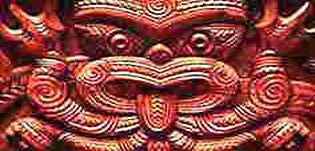|
Centuries later, when social malaise such as overpopulation and food shortages threatened Hawaiki's welfare, many chose to follow Kupe's path and travel south. These new immigrants soon established themselves in their adopted home, displacing or assimilating with the previous inhabitants. Maori culture subsequently developed with little or no interference from outside influences. Being warriors, they engaged in inter-tribal battles, mostly over territory, with the losers often becoming slaves or food (cannibalisation of the body was a way of securing an enemy's power or mana).
Over time, the Maori evolved a culture sustained by agriculture and hunting. They had a complex social structure of tribes, sub-tribes and clans, and a stratified society made up of nobility, priestly and slave classes. Genealogy (Whakapapa) was paramount as it delineated origins and status. Land was held communally, with each tribe and sub-tribe having a marae (meeting place where the tribe's ancestral spirits resided) and often living in a fortified village or pa. Intricate tattooing was frequently sported, with men of estimable rank being heavily tattooed from face to feet (women wore only a facial tattoo on the chin (moko). Clothing, ornaments and clubs were fashioned from feathers, the fur of dogs, bone and jade.
In 1840, the Treaty of Waitangi ceded Maori sovereignty to the Queen of England, in exchange for the Queen's protection in the exercise of their chieftainship over their lands, people, villages and possessions. The rights, privileges and duties of citizenship and a policy for land sales were also agreed upon. But the treaty's promise of benefits for both sides by regulating settlement and land sales proved a chimera: the demand for land by arriving settlers and the reluctance of the Maori to sell sparked a series of skirmishes which escalated into the Maori Wars (1860-1865). Pitted against superior numbers and firepower, the Maori eventually succumbed; the treaty, praised previously as a document of sincerity and utility, was hastily dumped, paving the way for widespread land confiscation by the Pakeha administration. Increased (and highly selective) immigration and sweeping social changes over the next hundred years did little to advance the cause of the Maori. But persistent pressure by Maori elders to redress the terms of the Treaty of Waitangi eventually paid off: in 1985, it was amended and financial reparations were made to a number of Maori tribes whose lands were found to have been unfairly confiscated. Today the Maori population (10% of New Zealand's population) is increasing and Maoritanga (Maori culture) is experiencing a flourishing renaissance. Songs, dances, traditional carving and even Maori language are now taught in New Zealand schools. Writers such as Witi Ihimera, Alan Duff and Keri Hulme have left an indelible mark on New Zealand and world literature; films such as Once Were Warriors have broken box office records in New Zealand and garnered much acclaim overseas. However, the melding of the Maori and Pakeha culture's and the country's apparent harmonious race relations came undone in early 1995 when the New Zealand government offered to establish a NZ$1 billion fund to compensate tribes for the loss of their lands. The poorly presented package was rejected and provoked a backlash among militant young Maoris who have occupied land claim areas, issued threats and trampled the New Zealand flag. Militancy has been accentuated by over 20 per cent unemployment among Maoris.
|



 Recommended Reading
Recommended Reading Lonely Planet Guides
Lonely Planet Guides Travellers' Reports
Travellers' Reports